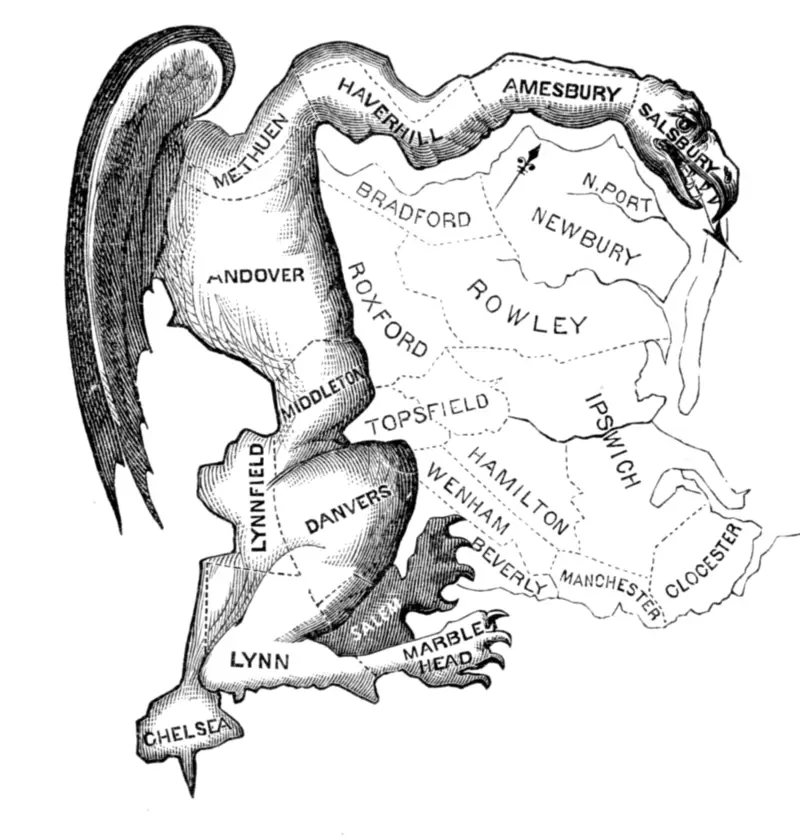Most of us have heard of “gerrymandering,” but most of us don’t really understand it. Let’s try an illustration. Let’s say a county has 100,000 people, and it gets four districts. Let’s also say that the county is perfectly split, 50,000 of one party and 50,000 of the other. You’d think that it’d be a fair fight, right? Nope. Every ten years, the party in power in the state gets to draw new district lines, based on census numbers.
The party in power can assure itself permanent control: The people in charge of drawing the new lines can look at results of the last election, so they know where the voters of each party live. They just draw the lines to favor their party. But how can they get the advantage if the number of voters of each party are exactly the same?
Here’s how: draw the lines so that three of the districts have, say, a 15,000 to 10,000 advantage. Even a bad candidate should be able to win if his or her party has a 3-2 registration advantage. THEN, you draw the lines so that you concentrate the other party into just one district—20,000 to 5,000, let’s say. With the exact same number of voters, the party in power can guarantee three times as many seats in government.
Once the lines are drawn this way, the party in control will be able to draw the next lines—and the next. The GOP caught on to this going into the 2010 redistricting, and thanks to computers and today’s extreme partisanship, the GOP has been able to gain control of a super majority of the states, even with a larger number of people in the country registered as Democrats.
The term “gerrymander” comes from the fact that our fifth vice president, Eldridge Gerry, was so good at drawing the lines to favor his party. One district was so weird that people thought it looked like a salamander. Thus, “Gerrymandering.”
Here’s a political cartoon, showing that district:
The practice has gotten so out-of-hand that the courts are becoming involved, in North Carolina, for example:
A U.S. federal court on Tuesday set a March 15 deadline for North Carolina state lawmakers to redraw legislative districts found to be racially “gerrymandered,” and ordered a new round of elections by next November for the 28 seats at stake.
In August, the same special three-judge panel ruled that nine state Senate districts and 19 state House districts, as carved out in a plan adopted by the Republican-controlled legislature in 2011, were unconstitutional.
The panel had told North Carolina’s legislature to start revamping its political maps immediately, but left the existing boundaries intact for the Nov. 8 state elections, because of time constraints.
“While special elections have costs, those costs pale in comparison to the injury caused by allowing citizens to continue to be represented by legislators elected pursuant to a racial gerrymander,” the panel wrote in its seven-page order on Tuesday.
Another court ruled about the issue in Wisconsin.
On Monday, a federal district court struck down Wisconsin’s state legislative districts, saying they were unconstitutionally gerrymandered to favor Republicans. The ruling is the first in three decades — and the second in the nation’s history — to strike down a district plan on partisan, rather than racial, grounds. And if other courts follow suit, the design of state legislative districts in more than a dozen other states could meet a similar fate.
Numerous times since the civil rights era, courts have struck down how partisan state legislatures set up legislative districts on the grounds that those decisions diminished the political power of racial minorities. But courts have been far less likely to intervene in cases where states organized voting districts to boost one party, preferring to not get involved in explicitly political matters.
This was why the decision Monday by the federal District Court for the Western District of Wisconsin was so significant. The court found that the Republican-held legislature had intentionally manipulated district lines to favor Republican candidates. And that manipulation was so extreme, it found, that it violated the “one person, one vote” principle and the Democratic voters’ rights to fair representation required by the Constitution’s promises of equal protection.
In short, by drawing district lines that pack Democrats into a small number of districts or spread them in small numbers across many districts, the court ruled that a Republican legislature was able to gain narrow victories in a disproportionately large number of districts.
As noted in the article, many other states are vulnerable to be re-evaluated, assuming that a court were to find injustice. But in today’s hyper-partisan atmosphere, even courts can’t be counted on to be impartial. The North Carolina case will likely go to the Supreme Court, which is also not impartial, as evidenced in the straight-party-line vote in 2000’s Bush vs. Gore decision. And some might say that the courts shouldn’t make political decisions at all—an encroachment on the legislative branch’s authority.
On March 26, 1962. . . The Supreme Court. . .held that the case arose under the Fourteenth Amendment’s Equal Protection Clause—and that it thus posed the same kind of legal, not political, question as a challenge to any other unequal state policy. Federal courts could and did decide such cases all the time, and this one should be no exception. . .
On Monday, the Court will hear two cases that exemplify the confusions and dangers of the political thicket. Both arise out of upper-South states that are hotly contested between the parties every election year—but that since the 2010 census and the required new round of district-drawing have been largely under the control of Republican legislatures. Both involve (as everyone admits) the deliberate use of political aims—in this case, protecting the Republican party’s legislative gains. Both sides admit as well as the deliberate use of racial considerations—ensuring that the new district maps do not violate Section 2 of the Voting Rights Act, which forbids changes in voting or election procedures that reduce the opportunity of minority voters to elect the candidates their preference. (Thus, any new districting plan has to take account of the racial makeup of the population, to avoid vote dilution or regression.)
The issue is complicated, because it’s not just politics. It’s also about race, since Black voters are also, usually, Democrats, making gerrymandering a question of whether it’s racially or politically motivated.
McCrory v. Harris is a challenge to U.S. House districts drawn by the Republican legislature in North Carolina. It raises a familiar question: in the South, where most Democrats are black, can the legislature use blackness as a proxy for politics? The plaintiffs, voters in North Carolina’s First and Twelfth Districts, allege that the legislature consciously “packed” black voters into those two majority-minority districts. The legislature admits a partisan, not a racial, motive—it was trying to create Republican districts elsewhere, it seems. A different three-judge court struck down the two districts as “textbook examples of racial gerrymandering.” In the North Carolina case, there’s no real claim that the districts look like “traditional” districts.
So, how will the Supreme Court decide?
This Court is split between a three-justice block (Chief Justice John Roberts, Justice Clarence Thomas, and Justice Samuel Alito) who distrust or (in Roberts’ case) openly despise the Voting Rights Act. These three Justices might be comfortable with the principle stated by the three-judge court in the Virginia case—that racial quotas are okay if the legislature makes does it in a way that looks normal.
The four moderate liberals support the Act and favor a careful application of its terms to district plans that seem to hide race behind politics. They are likely to vote against the Virginia plan.
Justice Anthony Kennedy is harder to read. He is not as comfortable as some on the Court with giving a wink and a nod to political gerrymandering. In a 2004 case, Vieth v. Jubelirer, the Court majority refused to decide a claim of political bias in districts. But Kennedy wrote separately to say that there may be partisan gerrymanders blatant enough to justify court intervention. Referring to Baker v. Carr, he wrote, “Our willingness to enter the political thicket of the apportionment process with respect to one-person, one-vote claims makes it particularly difficult to justify a categorical refusal to entertain claims against this other type of gerrymandering.”
Of course, gerrymandering is not just a GOP plot. The Chicago Tribune points out that Dems do it, too—but that doesn’t make it right.
Illinois is a blue state, voting Democratic in the past seven presidential elections. But the Democratic Party’s control of the state House is not the simple result of its ability to satisfy the citizenry. Democrats have also had the help of district lines drawn to help them at the expense of Republicans.
In 2012, Democratic House candidates got 52 percent of the vote statewide but captured 60 percent of the seats, report political scientist Kent Redfield of the University of Illinois at Springfield and policy consultant Cynthia Canary. In 2014, Democrats got 50.5 percent of the vote and 60 percent of the seats. This year, Madigan’s party again won 60 percent of the races. . .
Illinois Republicans know how that works. For the moment, partisan gerrymandering favors the GOP because it holds power in more states. But Republicans have been its victims just as often as Democrats — and, if the Supreme Court doesn’t curb the practice, will be again.
In the end, partisan gerrymandering is not really aimed at frustrating the party that is out of power. It’s aimed at foiling voters who might want to remove politicians from office.
My own opinion is that gerrymandering is a practice that is WAY past time to eliminate, like the “spoils system,” in which political parties handed out government jobs, like candy, to its supporters, regardless of their qualifications.
There is no reason why, by computer, we cannot design districts that are almost all rectangular. It’s just a matter of drawing the horizontal and vertical lines to encapsulate equivalent populations. Bim-botta-boom. And as the Tribune article states, it’s not just about unfair partisan advantage—it’s also about getting rid of “safe” districts, in which the parties cannot lose. The public should have the right to “throw the bums out”—and be able to do so.
Donate Now to Support Election Central
- Help defend independent journalism
- Directly support this website and our efforts

